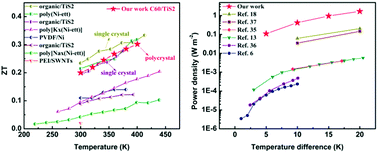Solution-printable fullerene/TiS2 organic/inorganic hybrids for high-performance flexible n-type thermoelectrics†
Abstract
Solution-printable and flexible thermoelectric materials have attracted great attention because of their scalable processability and great potential for powering flexible electronics, but it is challenging to integrate mechanical flexibility, solution-printability and outstanding thermoelectric properties together. In particular, such an n-type thermoelectric material is highly sought after. In this paper, 2D TiS2 nanosheets were exfoliated from layered polycrystalline powders, and then assembled with C60 nanoparticles, resulting in a new class of flexible n-type thermoelectric materials via a concurrent enhancement in the power factor and a reduction in thermal conductivity. The resultant C60/TiS2 hybrid films show a ZT ∼ 0.3 at 400 K, far superior to the state-of-the-art solution-printable and flexible n-type thermoelectric materials. In particular, such a thermoelectric property rivals that of single-crystal TiS2-based thermoelectric materials, which are expensive, difficult to synthesize, and unsuitable for solution printing. A solution of the C60/TiS2 hybrid was also used as an ink for printing large-area flexible and spatial thermoelectric devices. An outstanding output power of 1.68 W m−2 was generated at a temperature gradient of 20 K. This work paves the way for flexible, solution-printable, high-performance thermoelectric materials for flexible electronics.



 Please wait while we load your content...
Please wait while we load your content...
